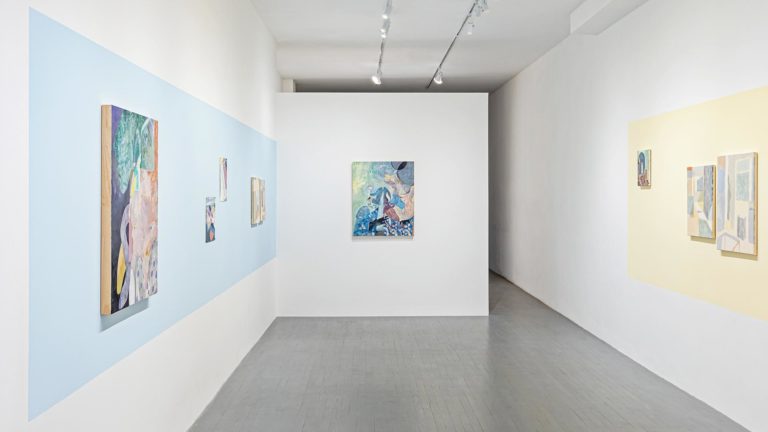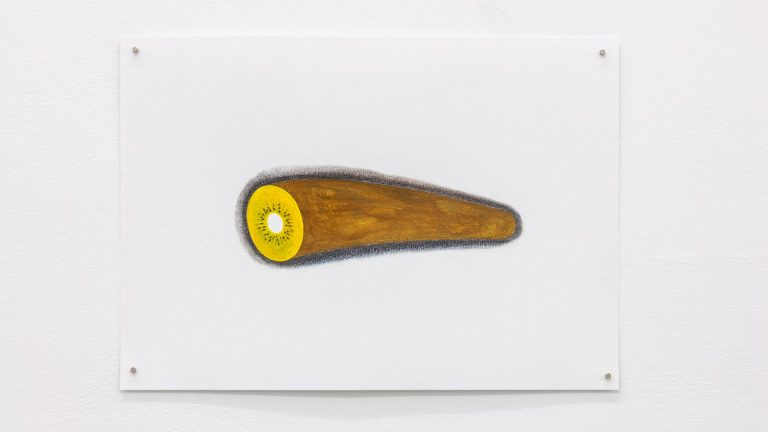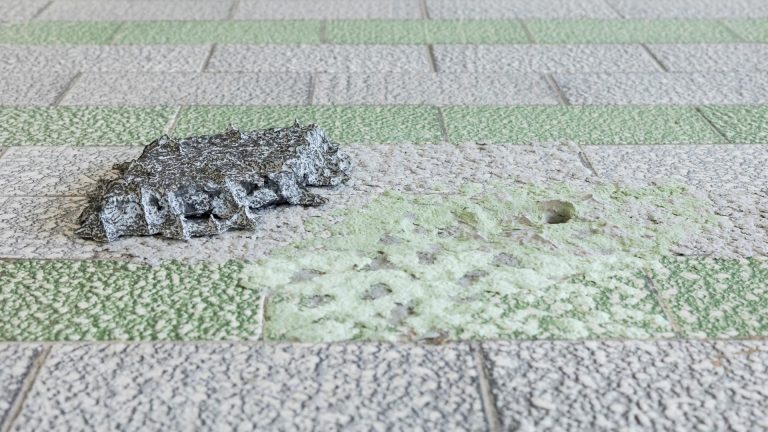Artists: Nick Bastis, Srijon Chowdhury, Silke Otto-Knapp, Hayley Tompkins, Barak Zemer
Exhibition title: February
Curated by: Jenni Crain and Lydia Glenn-Murray
Venue: Roberta Pelan, Toronto, Canada
Date: January 8 – February 11, 2017
Photography: all images copyright and courtesy of the artists and Roberta Pelan, Toronto
Where can we live but days?1 Not unlike the space between a door and its frame when one room is lit and another is not, and one changes into the other.2 Knowing of the room next-door only by its glow into this one.3 It is a dreamy evocation of transience, a memory of a place already left.4 It is a turned key but alsothe empty space of a lock.5 The most striking property of doors is resonance between two states which can be conveniently labeled as “open” and “closed.” Resonance is never a simple, unqualified fluctuation between two states; even so in this case.6 The nice thing about the inside of a door is that it is unclear if that space is in or out of the room. It’s nice to look at something and not really know where it is.7
Placed, only in its placeless-ness. A mere memory of a memory detached from that moment and construed into something not locked into time and place as we know it – not fixed – but rather fixated. The lure of something like what we(‘ve) know(n) but perhaps promising something more than we(’re)/(were) able to grasp.8
Systematic intervals in time and space, ultimately locating their position in-between reality and dream.9 The terrestrial continents are simply fragments of the Moon, which fell upon our planet. Through the influence of our tides, the Moon was impelled to move away, until it reached its present orbit. But a part of the lunar mass, perhaps half of it, had remained on Earth, forming the continents.10 In the expansion of her joy, the Moon filled the whole room with phosphorescent vapor, like a luminous poison; and all of the living light thought and said: “You shall suffer forever the influence of my kiss.”11 Isn’t the moon darktoo, most of the time?12
Thinking about personal mythologies13, do you ever feel as if there’s something, somewhere, waiting to happen? Another? And now you wonder if that really happened?14 The same feelings for the umpteenth time will tarnish, not in a disgraceful way, but telling of our history.15
1 From the 1953 Phillip Larkin poem “Days.” In Nine Contemporary Poets: A Critical Introduction Peter R. King writes that Larkin’s “desire not to be fooled by time leads to a concern to maintain vigilance against a whole range of possible evasions of reality” (1979).
2 From the 2015 poem “February 29” by Jane Hirshfield who was born in 1953, the same year Larkin’s “Days” was published. Hirshfield also translated the work of early women poets in collections such as The Ink Dark Moon.
3 Glenn-Murray, Lydia. B. 1992, founder of Chin’s Push, a project space in Los Angeles, CA. Excerpted from a brief email to JC on November 2, 2016.
4 Griffin, Jonathan. Excerpted from “Made in L.A.”, Frieze. June 2016. Griffin refers to Silke Otto-Knapp’s (b. 1970, Osnabruck Germany, and based in LA since 1995) large-scale painting in the LA biennial. “Like this exhibition,” Griffin goes on to say, “it is both hyperlocal and belonging to nowhere in particular.”
5 Excerpted from an anonymous email to JC and LGM on November 18, 2016.
6 Artschwager, Richard. “The Hydraulic Door Check.” Arts Magazine, Vol. 42, pp. 41-43. November 1967. Referred to JC & LGM by Nick Bastis. b. 1985, currently based between Brussels, BE and Vilnius, LT.
7 Excerpted from an anonymous email to JC and LGM on November 18, 2016.
8 Crain, Jenni. B. 1991, artist and curator based in Brooklyn, NY. Excerpted from email to LGM on October 30, 2016, in which Crain continues to discuss the subject of Barak Zemer’s (b. 1979, Jerusalem, Israel), based in Los Angeles, CA) photograph, Head, 2016.
9 Excerpted from the press release of Glasgow-based artist Hayley Tompkins’ (b.1971 Leighton Buzzard) exhibition “Optical Research” at Andrew Kreps Gallery, New York, NY, in 2009.
10 Calvino, Italo. Excerpted from “The Soft Moon” within “Part One – More Qfwfq” within “Time and the Hunter” within Calvino’s larger body of work known as the Cosmicomics. Within the paragraph from which this is excerpted, Calvino summarizes a theory calculated by H. Gerstenkorn in 1955 and later developed by H Alfven in 1969.
11 Excerpted from an unidentifiable translation of Charles Baudelaire’s “The Favours of the Moon”, which was published posthumously in 1869 within “Paris Spleen” – a collection of 51 of Baudelaire’s short prose poems.
12 Pastan,, Linda. Excerpted from “Why Are Your Poems so Dark?” This poem initially appeared in the August 2003 issue of Poetry Magazine alongside Tania Runyan’s “The Night Before” and Derick Burleson “Never Night.” The poem ends with the lines, “Ask the moon / Ask what it has witnessed.”
13 Chowdhury, Srijon (b. 1987, Bangladesh; lives and works between Portland, OR and Los Angeles, CA). Excerpted from an email to JC and LGM on December 1, 2016.
14 Norris, Hoke. Excerpted from “Weed of Sorrow,” 1950. Prairie Schooner, Vol. 24, No. 3, pgs. 207 & 213. University of Nebraska Press,1950. “What is a weed? A plant whose virtues have never been discovered.” – Ralph Waldo Emerson
15 Crain, Jenni. Excerpted from a poem written and shared with LGM on October 24,, 2016 in conjunction with this exhibition. Another line reads, “For you and me are not so like the unlike time and place to which we try to tune into.”
Barak Zemer, Head, 2016, Archival pigment print, framed, 35 x 23.5 inches / 88.9 x 59.69 cm
Hayley Tompkins, Metabuilt XXVII, 2009, Found object, gouache, photographs, 35 x 7 x 3 inches / 90 x 18 x 8 cm
Srijon Chowdhury, Wedding Bouquets Mirrored with, Hand and Leaf, 2016, Oil on linen, 29.5 x 24 inches / 74.93 x 60.96 cm
Silke Otto-Knapp, The Conversation, 2016, Watercolour on canvas, 23 x 18 inches / 60 x 45 cm
Nick Bastis, Treble, 2017, Turned brass, 4 x 1 x 1 inches / 10.16 x 2.54 x 4.54 cm



















